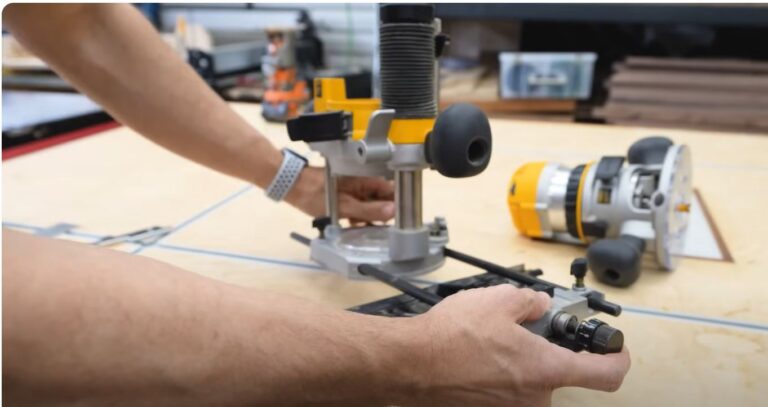5 Best Hand Routers for Woodworking
A hand router is a power tool used in woodworking to cut grooves, trim edges, hollow out areas, and shape wood with precision. Unlike large stationary routers, hand routers are portable, giving you flexibility for different projects.
Every woodworker whether DIY hobbyist or professional carpenter benefits from owning a good hand router. It allows you to create smooth edges, detailed patterns, and accurate joints that would be difficult with manual tools.
For this guide, we reviewed the best hand routers for woodworking in 2025. Our selection is based on motor power, speed control, durability, ease of use, and user reviews. This way, you can find the right tool for your projects and budget.
Top 5 Best Hand Routers for Woodworking in 2025
Choosing the right router can feel like a big decision. After all, this is a tool you’ll use for everything from cutting dados and grooves to creating beautiful decorative edges on your projects. Over the years, I’ve had the chance to get my hands on just about every type of router out there, and I’ve found that the best ones aren’t just about power they’re about finding the right tool for the job. Here are my top picks for 2025, broken down by what each one does best.
Best Overall Hand Router

If you’re looking for one router to rule them all, this is it. The best overall router is a versatile powerhouse that offers a perfect balance of power and precision. This type of router almost always comes as a combo kit, giving you both a fixed base for consistent, repeatable cuts and a plunge base for starting cuts in the middle of a board. In my experience, this is the most valuable setup for anyone who tackles a variety of projects.
Pros:
- Ultimate Versatility: With both a fixed and a plunge base, you’re ready for almost any task, from simple edge work to cutting intricate mortises and inlays.
- Powerful and Precise: These routers typically have a robust 2 to 2.5 HP motor, easily handling hardwoods without bogging down. The variable speed control and soft-start feature give you total control from the moment you hit the switch.
- Built to Last: A good overall router is built with a rugged, durable design that can take years of workshop abuse.
Cons:
- Hefty: The downside to all that power is the weight. They can be a little heavy for extended handheld use, especially on vertical surfaces.
- Higher Price Point: Since you’re getting two tools in one, these kits are a bigger initial investment than a single-base router.
Best Budget Hand Router

When I was first starting out, I learned a simple truth: the best tool is the one you can afford. An excellent budget router proves that you don’t need to break the bank to get a capable tool. This type of router is usually a fixed-base model with a solid motor around 1.5 HP. It’s a no-frills workhorse that simply gets the job done. I’ve seen these routers stand up to years of use in small shops and home workshops, and they’re a great entry point into routing.
Pros:
- Incredible Value: You get reliable performance for a fraction of the cost of a premium model.
- Durable and Simple: With fewer electronic parts and moving pieces, these routers are often incredibly tough and easy to maintain.
- Great for Router Tables: Because of their simple, fixed-base design, they’re perfect for a dedicated spot in a router table setup.
Cons:
- Lacks Features: You’ll likely miss out on things like variable speed control and soft start, which can make some cuts more challenging.
- Fixed Base Only: The lack of a plunge base limits the types of cuts you can make, like mortises or cutouts in the middle of a board.
Best Premium Hand Router

This is the kind of router you buy when you want the best of the best, with zero compromises. A premium router is an investment in professional-grade power, precision, and performance. I’ve used these beasts on long-running, demanding projects, and they just never quit. They’re built with exceptionally powerful 3+ HP motors, advanced electronics to maintain constant speed under load, and the smoothest depth adjustment systems on the market.
Pros:
- Unmatched Power: These routers can power through the densest hardwoods and handle large-diameter bits for tasks like panel raising without any strain.
- Flawless Precision: The micro-fine adjustments and electronic feedback mean your cuts will be perfectly clean and accurate, every single time.
- Built for Professional Use: They’re designed for continuous, heavy-duty work, making them a top choice for a shop router or for mounting in a router table.
Cons:
- Very Heavy: Their weight makes them unwieldy for most handheld applications. They are truly meant for demanding table-mounted tasks.
- High Price Tag: This level of performance comes at a premium, making them a significant investment.
Best Compact Hand Router

When a full-size router is just too much to handle, a compact hand router is the perfect solution. I’ve often found myself reaching for one of these for the quick, small jobs that don’t need a lot of power. Also known as a palm router, its small size, and lightweight design make it easy to use with just one hand. It’s the ideal tool for trimming veneer, rounding over small edges, and cutting hinge mortises.
Pros:
- Lightweight and Portable: Their size makes them a breeze to use for a single, small task or for on-site work. They won’t cause fatigue like their bigger cousins.
- Great for Detail Work: They offer excellent visibility and control, perfect for intricate cuts or fine joinery.
- Easy to Use: Their simple design is very approachable for both beginners and experienced woodworkers.
Cons:
- Limited Power: With motors around 1 to 1.25 HP, they aren’t built for hogging out a lot of material. They can struggle with deep cuts in hardwoods.
- Only 1/4-inch Collet: The smaller collet size means you can’t use the larger 1/2-inch shank bits, which are more common for heavy-duty work.
Best Hand Router for Beginners

If you’re just getting started, the best router is one that’s a pleasure to learn on. It should be a tool that provides enough power for common tasks while also having the features that you can grow into as your skills improve. I always recommend a mid-range model with a manageable weight, a soft-start feature to prevent jolts on startup, and good overall ergonomics. This type of router is more forgiving than a heavy-duty model and is versatile enough for a wide range of first-time projects.
Pros:
- User-Friendly: They are generally lighter and easier to handle than full-size routers. The soft start makes them much less intimidating to use.
- Good Feature Set: Most have variable speed control, which is a crucial feature for learning how to match the bit to the wood.
- Versatile: They’re well-suited for a variety of tasks, so you can explore different woodworking techniques without needing to buy a new tool.
Cons:
- Not a Forever Tool: While they are an excellent starting point, you’ll likely want to upgrade to a more powerful model if you get into more advanced or large-scale projects.
- Can Lack Power for Certain Tasks: While they handle most beginner projects well, they may struggle with demanding cuts in very hard or dense woods.
How to Choose the Best Hand Router for Woodworking
Choosing the right hand router isn’t just about picking the most expensive or powerful one. It’s about matching the tool’s capabilities to your specific needs. Here’s a breakdown of the most important factors to consider before you buy.
Power and Motor Size The power of a hand router is typically measured in horsepower (HP) or amps. Think of it like the engine of a car the more power it has, the more easily it can handle tough jobs without slowing down.
- Compact Routers: These are small, lightweight tools, often with motors between 1 and 1.5 HP. They’re perfect for light-duty tasks like trimming laminate, rounding over edges, and cutting small grooves. They’re easy to handle and ideal for one-handed operation.
- Mid-Size Routers: These are the most common type, with motors ranging from 1.75 to 2.5 HP. They’re the true workhorses of the workshop, offering a great balance of power and maneuverability. They can handle most projects, from cutting dadoes in plywood to profiling a tabletop.
- Large Routers: With motors of 3 HP and up, these are the heavy-duty machines. They’re best suited for large projects that require a lot of material removal or for being permanently mounted in a router table. They’re too heavy and powerful for most handheld tasks but are indispensable for professional shops.
Fixed Base vs. Plunge Base Hand Routers This is a critical distinction that determines how a router operates. Many routers today are sold in combo kits that include both bases, giving you the best of both worlds.
- Fixed Base Routers: The bit depth on a fixed base router is set and locked in a single position before the cut. This design makes it incredibly stable and consistent, which is why it’s the preferred choice for edge routing, creating dadoes and rabbets, and for use in a router table. The lack of a moving mechanism means it’s generally more affordable and more rigid.
- Plunge Base Routers: A plunge router allows you to “plunge” the bit down into the workpiece to start a cut in the middle of a board. This makes it ideal for tasks like cutting mortises for joinery, creating stopped grooves for inlays, or making cutouts in panels. The spring-loaded mechanism gives you versatility that a fixed base router can’t match.
Speed Control and Precision The speed of a router’s motor, measured in RPM (revolutions per minute), is just as important as its power. A router with variable speed control is a must-have feature for any serious woodworker. Different materials and different-sized bits require different speeds to cut cleanly. For example, a large-diameter panel-raising bit needs to be run at a lower RPM to prevent the wood from burning and to reduce kickback.
Beyond the motor speed, look for micro-fine depth adjustment. This feature allows you to make incredibly small, precise changes to the bit’s height, often in increments as small as 1/64 of an inch. This level of precision is essential for creating tight-fitting joinery and flawless decorative profiles.
Ergonomics and Ease of Handling A comfortable router is a safer and more precise router. Since you’ll be holding and guiding the tool, pay close attention to its ergonomics.
- Handles: Look for models with comfortable handles that provide a secure grip. Some routers have a traditional dual-knob handle, while others have a D-handle with a trigger switch for better control.
- Weight and Balance: A heavy router can cause fatigue, leading to mistakes. A well-balanced router will feel stable in your hands and be easier to guide along a straight edge.
- Convenience: Look for features like soft start (which prevents the tool from lurching on startup), integrated LED lights to illuminate the workpiece, and an effective dust collection port.
Price and Value for Money The price of a hand router can range from under $100 for a basic model to several hundred dollars for a high-end, feature-packed machine. For beginners, a mid-range router from a reputable brand offers the best value. It will have enough power and features to handle most projects and will be a reliable tool you can grow with. For professionals, investing in a premium router pays off in long-term durability, precision, and performance.
Quick Comparison Table – Best Hand Routers at a Glance
This table helps readers quickly compare features before diving into detailed reviews. It highlights the most important buying factors:
-
Brand | Model – Name of the router (e.g., Bosch 1617EVSPK, Makita RT0701C).
-
Motor Power – Measured in horsepower (HP) or watts; higher power = better for heavy-duty jobs.
-
Speed – Variable speed ranges (e.g., 10,000–30,000 RPM) that let you match cutting speed to wood type.
-
Best For – Who should use it (beginners, professionals, cabinet makers, etc.).
-
Amazon Link – Direct link so readers can check the current price and reviews.
Example (just sample data to show format):
| Brand | Model | Motor Power | Speed | Best For | |
|---|---|---|---|---|---|
| Bosch | 1617EVSPK | 2.25 HP | 8,000–25,000 RPM | Best Overall | |
| Makita | RT0701C | 1.25 HP | 10,000–30,000 RPM | Best Compact Router | |
| DeWalt | DWP611 | 1.25 HP | 16,000–27,000 RPM | Best for Beginners | |
| Triton | TRA001 | 3.25 HP | 8,000–21,000 RPM | Heavy-Duty Projects | |
| Ryobi | P601 | 18V Cordless | 29,000 RPM | Budget Pick |
Best Hand Routers by Use Case
When it comes to woodworking, there is no single tool that works perfectly for everyone. The best hand router for you depends entirely on what you plan to use it for. Whether you’re a casual hobbyist or a professional, matching the tool to the task is the key to both efficiency and satisfaction.
For DIY woodworking: For the weekend warrior tackling a variety of home projects, a versatile combo kit is the gold standard. A mid-size router with a 1.75 to 2.25 horsepower motor and both a fixed and plunge base gives you the flexibility to handle everything from edge-profiling a coffee table to cutting precise dadoes for a bookshelf. This all-in-one solution is a fantastic value and provides a learning curve that a beginner can grow with.
For professional carpentry: Professional carpenters need tools that are powerful, durable, and reliable enough to stand up to daily use on a job site. For this reason, many pros own two routers: a dedicated heavy-duty fixed-base router (3+ HP) that’s often used for table-mounted work in the shop, and a separate, powerful plunge router for handheld tasks like cutting mortises, fluting columns, or working on site. The extra power ensures they can chew through tough materials and large bits without bogging down.
For furniture making: Precision is the name of the game in furniture making. The ideal router for this craft is a mid-size model with variable speed control and a highly accurate micro-fine depth adjustment. A soft-start feature is also crucial to prevent the tool from lurching on start-up, which could damage a delicate workpiece. Look for a router with excellent ergonomics that feels balanced in your hands, as you’ll be spending a lot of time with it.
For cabinetry and fine detailing: When it comes to small, intricate tasks like trimming laminate, routing hinge mortises, or adding a decorative edge to a cabinet door, a compact or trim router is the perfect tool. Their lightweight design and smaller profile allow for incredible control and precision. They are often operated with one hand, which frees up your other hand for guiding the workpiece, making them indispensable for any fine detailing work.
Hand Router Maintenance Tips
A hand router is a major investment, and proper care is the key to ensuring it lasts for years. A well-maintained router also performs better and more safely.
Cleaning and lubrication: After every use, take a moment to unplug your router and wipe it down. Fine sawdust and wood pitch can build up on the motor housing, in the vents, and especially in the collet. Use a stiff brush and a cleaning solution (like denatured alcohol) to remove any caked-on residue from the collet and bit shank. This prevents the bit from slipping, which can be incredibly dangerous. A light application of a dry lubricant (like a PTFE spray) on the plunge columns of a plunge router will keep the action smooth and effortless.
Replacing bits safely: Always unplug your router before you even think about changing a bit. Use the correct wrenches to loosen the collet nut. When inserting a new bit, make sure it is clean and seated at least halfway down the collet to ensure a secure grip. Never overtighten the collet, as this can damage the bit shank or the collet itself.
Storing for longer life: Store your router in a dry, dust-free environment. A workshop that experiences high humidity can cause metal parts to rust. If possible, store it in its original case or a dedicated cabinet. Always remove the bit from the collet before storing the router for any length of time. This prevents the collet from becoming fatigued, which could lead to a loose grip on the bit in the future.
Safety Tips When Using Hand Routers
A router’s bit spins at tens of thousands of RPM, making it one of the most powerful and potentially dangerous tools in your workshop. Respecting the tool and following proper safety procedures is non-negotiable.
Proper grip and handling: Always hold the router with two hands, keeping it firmly planted on the workpiece. A secure grip gives you control over the tool’s powerful torque. The router’s feed direction is also critical. Always move the router from left to right when cutting an outside edge (against the direction of the bit’s rotation). This creates resistance and keeps the router from running away from you, which can cause kickback.
Dust control and protection: Router bits produce an enormous amount of fine dust, which can be a serious health hazard if inhaled over time. Always wear a respirator or dust mask to protect your lungs. Safety glasses or a face shield are also a must to protect your eyes from flying debris. And don’t forget hearing protection; a router’s high-pitched whine can cause permanent hearing damage with prolonged exposure. Whenever possible, connect your router to a dust collection system to keep the air clean and improve visibility.
Avoiding kickback: Kickback occurs when the router bit grabs the wood and the tool is suddenly and violently thrown back at you. To avoid this, always secure your workpiece firmly with clamps. Never try to hold it with your hands. Use sharp bits, as dull bits are more likely to grab the wood. Finally, always take multiple, shallow passes instead of trying to remove all the material in a single, deep cut.
Fixed Base vs Plunge Base Hand Routers – Which One Should You Buy?
This is one of the most common questions for new woodworkers. The choice between a fixed and a plunge base router depends entirely on your primary needs.
- Fixed Base Routers are simple, rigid, and great for consistent cuts. Their pros include a more stable design, being the preferred choice for router tables, and a more affordable price point. Their cons are a lack of versatility for plunge cuts in the middle of a board and the inability to change bit height during a cut.
- Plunge Base Routers offer unmatched versatility. Their pros include the ability to start cuts in the middle of a workpiece, a convenient mechanism for cutting mortises or stopped grooves, and the ability to control the cutting depth on the fly. Their cons are a higher price, a more complex mechanism, and being less rigid for edge work.
Verdict: If you are a beginner or a DIYer, a combo kit that includes both a fixed and a plunge base is the best option. It gives you the flexibility to handle almost any project without having to buy two separate tools.
Corded vs Cordless Hand Routers – Pros and Cons
The rise of battery technology has brought cordless options to the forefront of woodworking. The choice between corded and cordless is a trade-off between power and convenience.
- Corded Hand Routers are the traditional choice. Their pros are a reliable, consistent power source with no limit on runtime, and they are generally more powerful and more affordable. Their con is the power cord itself, which can get in the way or become a trip hazard.
- Cordless Hand Routers offer unmatched portability. Their pros are the freedom to move anywhere without being tethered to an outlet, and they are perfect for quick jobs on a job site. Their cons are limited battery runtime, a power output that may drop as the battery drains, and a higher cost for the tool and batteries.
Hand Router Accessories You Should Consider
A router is only as good as its accessories. These are a few essential add-ons that can transform your router’s capabilities.
- Router bits: The most crucial accessory. A good starter set will include a variety of bits for different profiles, like roundovers, chamfers, and straight bits.
- Edge guides: These are invaluable for ensuring your cuts are straight and parallel to the edge of your workpiece.
- Router tables: A router table transforms your handheld tool into a stationary machine. It’s the safest way to work on smaller pieces and provides superior control and precision for tasks like raising panels or cutting intricate joinery.
- Dust collection adapters: These allow you to connect your router to a shop vacuum, which dramatically improves dust control, keeps your workspace cleaner, and improves your visibility while you work.
Common Mistakes to Avoid with Hand Routers
Even experienced woodworkers make mistakes. Here are some of the most common ones to watch out for.
- Taking too deep a cut: This puts a massive strain on the motor and can lead to burning, tear-out, or even dangerous kickback.
- Moving too fast or too slow: Moving too fast can cause rough cuts and a bogged-down motor, while moving too slow can cause burn marks on the wood.
- Cutting in the wrong direction: Always feed the router against the direction of the bit’s rotation.
- Failing to secure the workpiece: A shifting workpiece is a recipe for disaster. Always use clamps.
- Using dull bits: A dull bit can cause tear-out, burning, and put unnecessary stress on the motor.
Frequently Asked Questions (FAQ)
What is the best hand router for beginners? The best router for a beginner is a mid-size combo kit with variable speed and a soft-start feature. It’s user-friendly and versatile enough for you to learn and grow with.
Are cordless hand routers powerful enough for woodworking? Yes, but they have limitations. For quick, light-duty tasks like trimming and rounding over, they are perfectly sufficient. For heavy-duty jobs like cutting deep mortises in hardwood, a corded router is still the better choice.
Can a hand router be mounted on a table? Yes, and it’s a very common practice. A fixed-base router is ideal for this, as its rigid design provides the stability needed for precise cuts.
What’s the difference between a trim router and a hand router? A trim router is a type of hand router, specifically a smaller, more compact version. It’s designed for light-duty tasks, typically has a 1/4-inch collet, and is often used for trimming laminate and small detailing work. A full-size hand router is larger, more powerful, and can handle a wider range of tasks with both 1/4-inch and 1/2-inch bits.
Final Verdict – Which Hand Router is Right for You?
The right hand router for you depends on your needs. For the all-around woodworker, a mid-size combo kit with variable speed and soft-start is the best investment. If you’re a professional, you’ll need a dedicated, heavy-duty router for your shop and a separate plunge router for on-site work. For detailed work and small projects, a compact router is a must-have. No matter which one you choose, remember that the most important thing is to understand your tool, maintain it properly, and always, always prioritize safety.







